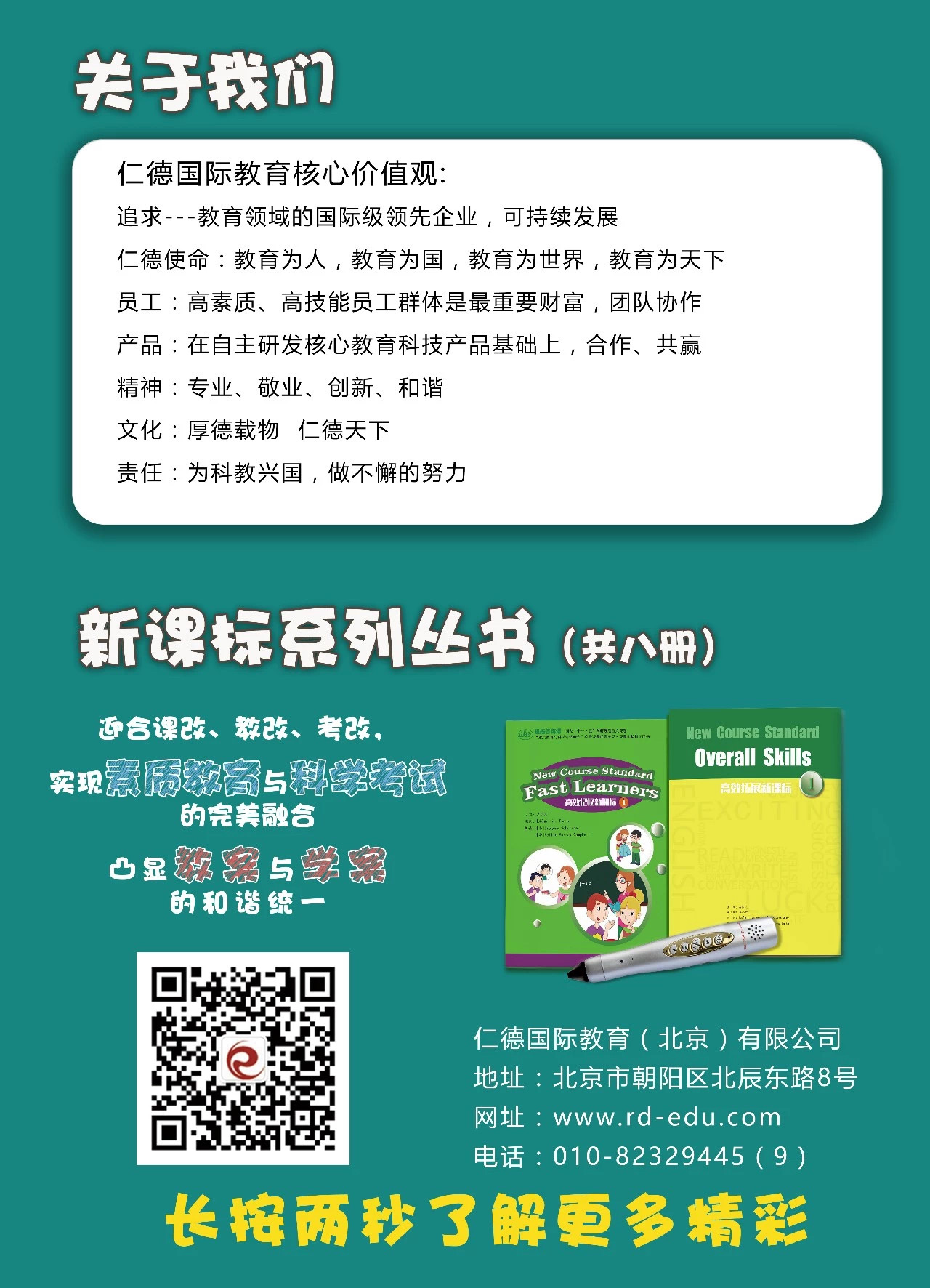幹貨|小(xiǎo)學英語必考知識點總結,真是太有(yǒu)用(yòng)了!
作者: 來源:本站 發表時間:2020-11-10 11:19:53 浏覽:次
任何科目的(de)學習(xí),在考點知識上(shàng)都(dōu)需要有(yǒu)系統的(de)總結和(hé)記憶,這樣才可(kě)以有(yǒu)效的(de)在考試中提分(fēn)。隻有(yǒu)清楚的(de)了解每個(gè)知識點的(de)規律,并熟記于心,才能(néng)不落入考點“陷阱”。
希望今天分(fēn)享的(de)這些知識點,能(néng)幫助到(dào)孩子們的(de)學習(xí)。
我 (I) 用(yòng) am ,你(nǐ) (you) 用(yòng) are , is 跟著(zhe)他(tā) (he) ,她 (she) ,他(tā) (it) 。
單數名詞用(yòng) is,複數名詞全用(yòng) are 。
變否定,更容易,be 後 not 加上(shàng)去。
變疑問,往前提,句末問号某丢棄。
還有(yǒu)一條須注意,句首大(dà)寫莫忘記。
✪ this 和(hé) that 是指示代詞,it 是人(rén)稱代詞。
✪ 距離(lí)說話(huà)人(rén)近的(de)人(rén)或者物(wù)用(yòng) this ,距離(lí)說話(huà)人(rén)遠的(de)人(rén)或物(wù)用(yòng) that 。
如(rú):
-This is a flower. 這是一朵花。(近處)
-That is a tree. 那是一棵樹。(遠處)
✪ 放(fàng)在一起的(de)兩樣東西(xī),先說 this,後說 that 。
如(rú):
-This is a pen,that is a pencil. 這是一支鋼筆(bǐ),那是一支鉛筆(bǐ)。
✪ 向别人(rén)介紹某人(rén)說 This is...,不說 That is...。
如(rú):
-This is Helen. 這是海(hǎi)倫.
-Helen,this isTom. 海(hǎi)倫,這是湯姆。
✪ This is 不能(néng)縮寫,而 That is 可(kě)以縮寫。
如(rú):
-This is a bike. That's a car. 這是一輛自行(xíng)車(chē),那是一輛轎車(chē)。
✪ 打電話(huà)時,介紹自己用(yòng) this ,詢問對方用(yòng) that 。
如(rú):
-Hello! Is that Miss Green? 喂,是格林小(xiǎo)姐嗎?
-Yes,this is.Who's that? 是的(de),我是,你(nǐ)是誰?
注意:雖然漢語中使用(yòng)”我“和(hé)”你(nǐ)“,但(dàn)英語中打電話(huà)時絕不可(kě)以說:I am..., Are you...? Who are you?
✪ 在回答 this 或 that 做主語的(de)疑問句時,要用(yòng) it 代替 this 或者 that 。
如(rú):
-Is this a notebook? 這是筆(bǐ)記本嗎?
-Yes,it is. 是的(de),它是。
-What's that? 那是什(shén)麽?
-It's a kite. 是隻風筝。
✪ this, that, these 和(hé) those 是指示代詞。
these 是 this 的(de)複數形式,指時間、距離(lí)較近的(de)或下面要提到(dào)的(de)人(rén)或事;
those 是 tha t的(de)複數形式,指時間、距離(lí)較遠或前面已經提到(dào)過的(de)人(rén)或事物(wù)。
如(rú):
-This is my bed. That is Lily’s bed. 這是我的(de)床。那是莉莉的(de)床。
-These pictures are good. 那些畫很好。
- Are those apple trees? 那些是蘋果樹嗎?
✪ 在回答主語是 these 或 those 的(de)疑問句時,通常用(yòng) they 代替 these 或 those 以避免重複。
如(rú):
-Are these / those your apples? 這些(那些)是你(nǐ)的(de)蘋果嗎?
-Yes, they are. 是的(de),他(tā)們是。
-Jim’s coat. 吉姆的(de)外套
-Jeff’s mother. 傑夫的(de)媽(mā)媽(mā)
✪ 以s結尾的(de)複數名詞,隻加"’"
-Teachers’ Day 教師(shī)節
-the twins’ books 雙胞胎的(de)書(shū)
✪ 不以s結尾的(de)不規則的(de)名詞複數,加"’s"
-Children’s Day 兒童節
-men’s shoes 男式鞋
✪ 表示兩者共同擁有(yǒu)時,隻在最後一個(gè)名詞後加"’s"
-Lucy and Lily’s mother 露茜和(hé)莉莉的(de)媽(mā)媽(mā)(共同的(de)媽(mā)媽(mā),一個(gè)媽(mā)媽(mā))
✪ 表示兩者各自擁有(yǒu)時,要在每個(gè)名詞後加"’s"
-Lucy’s and Kate’s rooms 露茜和(hé)凱特的(de)房間(各自的(de)房間,兩間房子)
✪ There be 句型主要用(yòng)以表達“某處(某時)有(yǒu)某人(rén)(某物(wù))。”
其基本結構爲“There be+某物(wù)(某人(rén))+某地(dì)(某時)”
其中 there 是引導詞,沒有(yǒu)詞義;主語是 be 後面的(de)名詞, be 是謂語動詞,在一般現在時中 be 隻用(yòng) is 和(hé) are 兩種形式。
下面這首歌訣可(kě)幫你(nǐ)巧記 there be 句型結構:
There be 放(fàng)句首,主語跟在後。地(dì)、時放(fàng)句末,強調置前頭。
如(rú):
-There is a book on the desk. 有(yǒu)本書(shū)在桌子上(shàng)。
有(yǒu)時爲了強調地(dì)點,也(yě)可(kě)把介詞短語放(fàng)在句首。
如(rú):
-On the desk there is a book. 書(shū)桌上(shàng)有(yǒu)本書(shū)。
✪ There be 句型中的(de) be 動詞如(rú)何确定呢?
請先看看下面這首歌訣:
Be 動詞,有(yǒu)三個(gè),am,is 還有(yǒu) are。
“There be”真特别,不留 am 隻留倆,那就是 is 還有(yǒu) are。
要用(yòng) is 還是 are,須看其後的(de)名詞是單數還是複數。
若是單數或不可(kě)數名詞用(yòng) is,否則就用(yòng) are。
如(rú):
-There is a tree behind the house.
-There is some water (水(shuǐ)) in the bottle (瓶子) .
-There are some pears in the box.
✪ 注意:如(rú)果 “be” 後的(de)主語是由and連接的(de)兩個(gè)或兩個(gè)以上(shàng)的(de)名詞,那麽 be 的(de)形式要遵循“遠親不如(rú)近鄰”的(de)原則。
也(yě)就是說,“be” 的(de)形式是由與它最近 的(de)那個(gè)名詞來确定的(de)。若那個(gè)名詞是單數或不可(kě)數名詞要用(yòng) is,是複數就用(yòng) are。
如(rú):
-There is a book and some pens on the floor.
-There are some pens and a book on the floor.
like 用(yòng)作及物(wù)動詞,譯爲“喜歡”
✪ 後接名詞或代詞,表示喜歡某人(rén)或某物(wù)。
如(rú):
-I like the baby very much. 我非常喜歡這個(gè)小(xiǎo)孩。
✪ 後接動名詞(v. -ing),表示“喜歡做某事”,著(zhe)重于習(xí)慣、愛好。
如(rú):
-Tom likes playing football. 湯姆喜歡踢足球。
✪ 後接動詞不定式 (to do ),表示“偶爾地(dì)喜歡做某事”,著(zhe)重于某次具體的(de)行(xíng)爲。
如(rú):
-I like reading, but I like to watch TV this evening. 我喜歡讀(dú)書(shū),但(dàn)我今晚想看電視。
句子單數變複數
注意以下五要素:
✪ 主格人(rén)稱代詞要變成相(xiàng)應的(de)複數主格人(rén)稱代詞,
即“”
I→we, you→you,
she,he,it→ they。
如(rú):
-She is a girl. →They are girls.
✪ am,is 要變爲 are。
如(rú):
-I’m a student. →We are students.
✪ 不定冠詞 a, an 要去掉。
如(rú):
-He is a boy. →They are boys.
✪ 普通單數名詞要變爲複數形式。
如(rú):
-It is an apple. →They are apples.
✪ 指示代詞 this,that 要變爲 these,those。
如(rú):
-This is a box. →These are boxes.
英語中月(yuè)份和(hé)星期名稱都(dōu)是專有(yǒu)名詞,它們的(de)首字母必須大(dà)寫,并且前面無需用(yòng)冠詞。
✪ 用(yòng)英語表示日期,其順序爲月(yuè)+日+年,日和(hé)年之間需用(yòng)逗号隔開(kāi)。
如(rú):
-August 2nd,2003 (2003年8月(yuè)2日)。
✪ 也(yě)可(kě)以用(yòng)日+月(yuè)+年來表示。
如(rú):
-10th May,2003 (2003年5月(yuè)10日)
✪ 英語日期前介詞的(de)使用(yòng):若指在哪一年或哪一月(yuè),則用(yòng)介詞 in,若具體到(dào)某一天,則需用(yòng)介詞 on。
✪ 直讀(dú)式,即直接讀(dú)出時間數字。
-7:05 seven five
-8:16 eight sixteen
✪ 過、差式,即幾點差幾分(fēn),幾點過幾分(fēn)。
(以30分(fēn)爲分(fēn)界線)
-1:25 twenty-five past one
-2:30 half past two
-3:43 seventeen to four
-4:38 twenty-two to five
✪ 12小(xiǎo)時制(zhì)。
-6:00 a.m. 上(shàng)午6點
-8:20 p.m. 下午8點20分(fēn)
✪ 24小(xiǎo)時制(zhì) 。
-13:00 13點鍾
-22:15 22點15分(fēn)
✪ 15分(fēn)可(kě)用(yòng)quarter 。
-4:15 a quarter past four
-5:45 a quarter to six
✪ 時間前通常用(yòng)at。
-at 5 o’clock
-at 7:30 p.m.
✪ 想幹什(shén)麽用(yòng) want to do sth
-They want to join the sports club. 他(tā)們想加入運動俱樂(yuè)部。
✪ 第三人(rén)稱單數作主語,want 要作變化
-He wants to play basketball.
-Li Xia wants to play the piano.
✪ 變疑問句,否定句要借助助動詞 do 或 does.
①
-Do you want to play soccer ball ?
-Yes, I do . / No , I don’t.
②
-Does he want to go home by bus ?
-Yes, he does . / No , he doesn’t.


